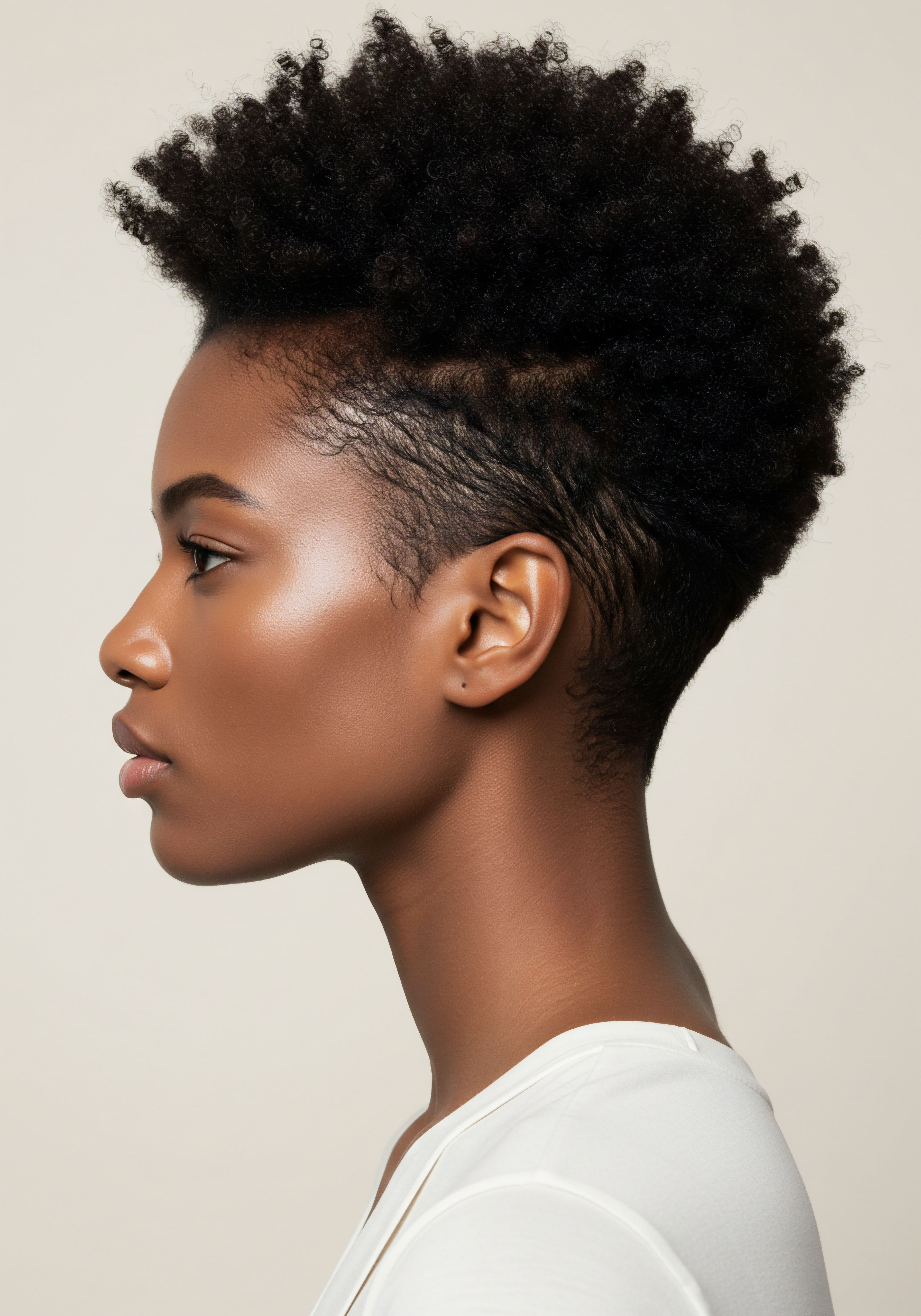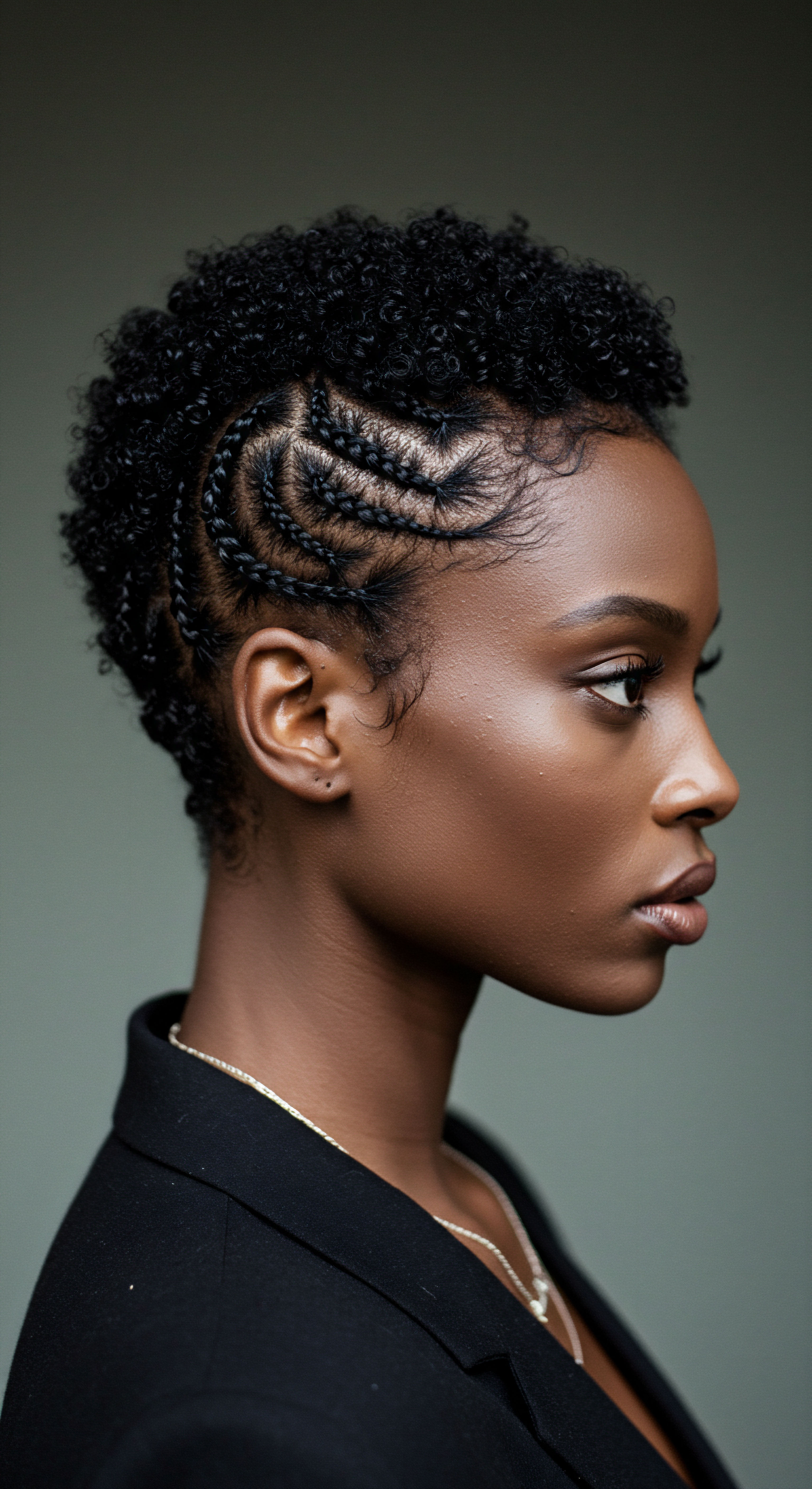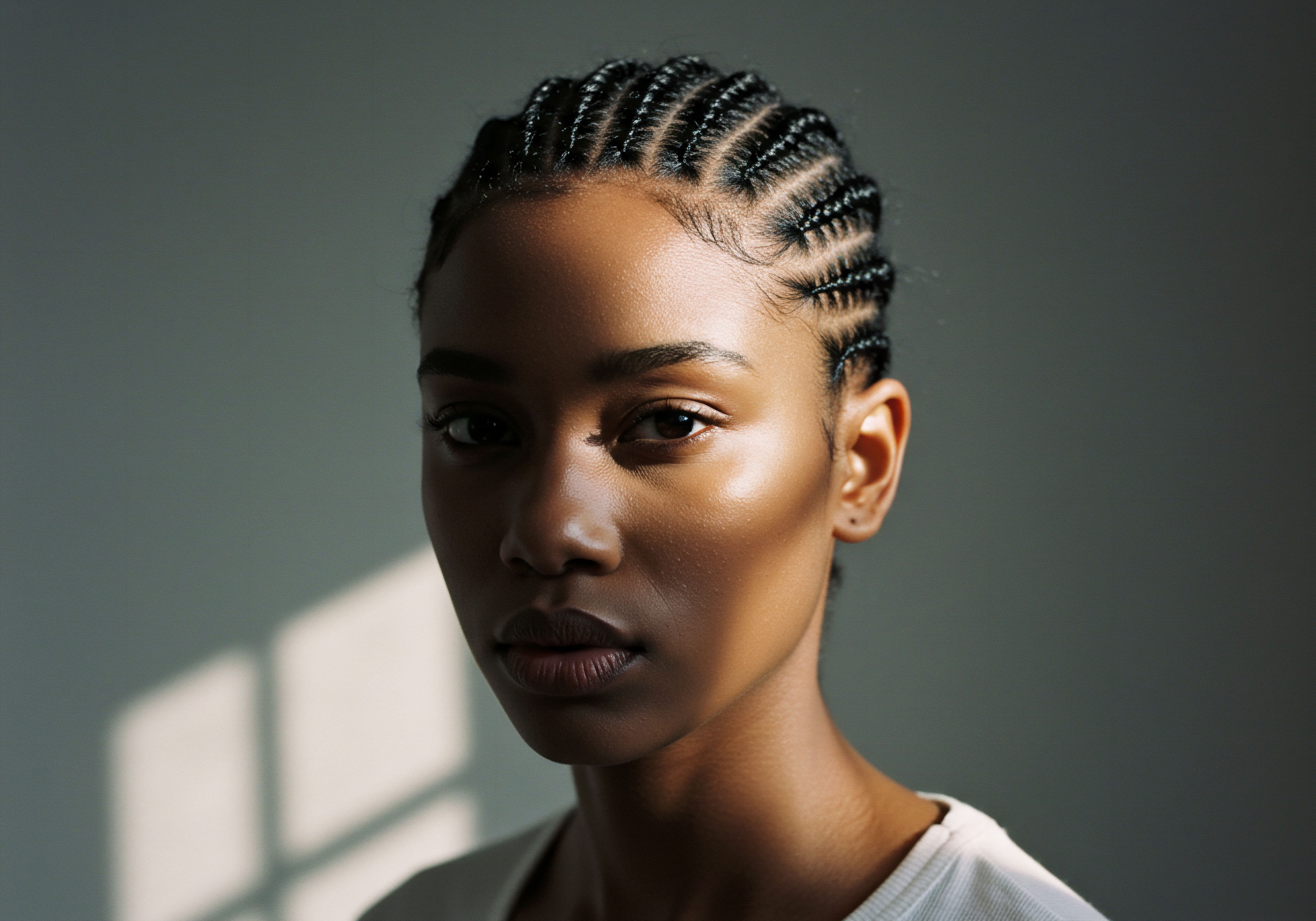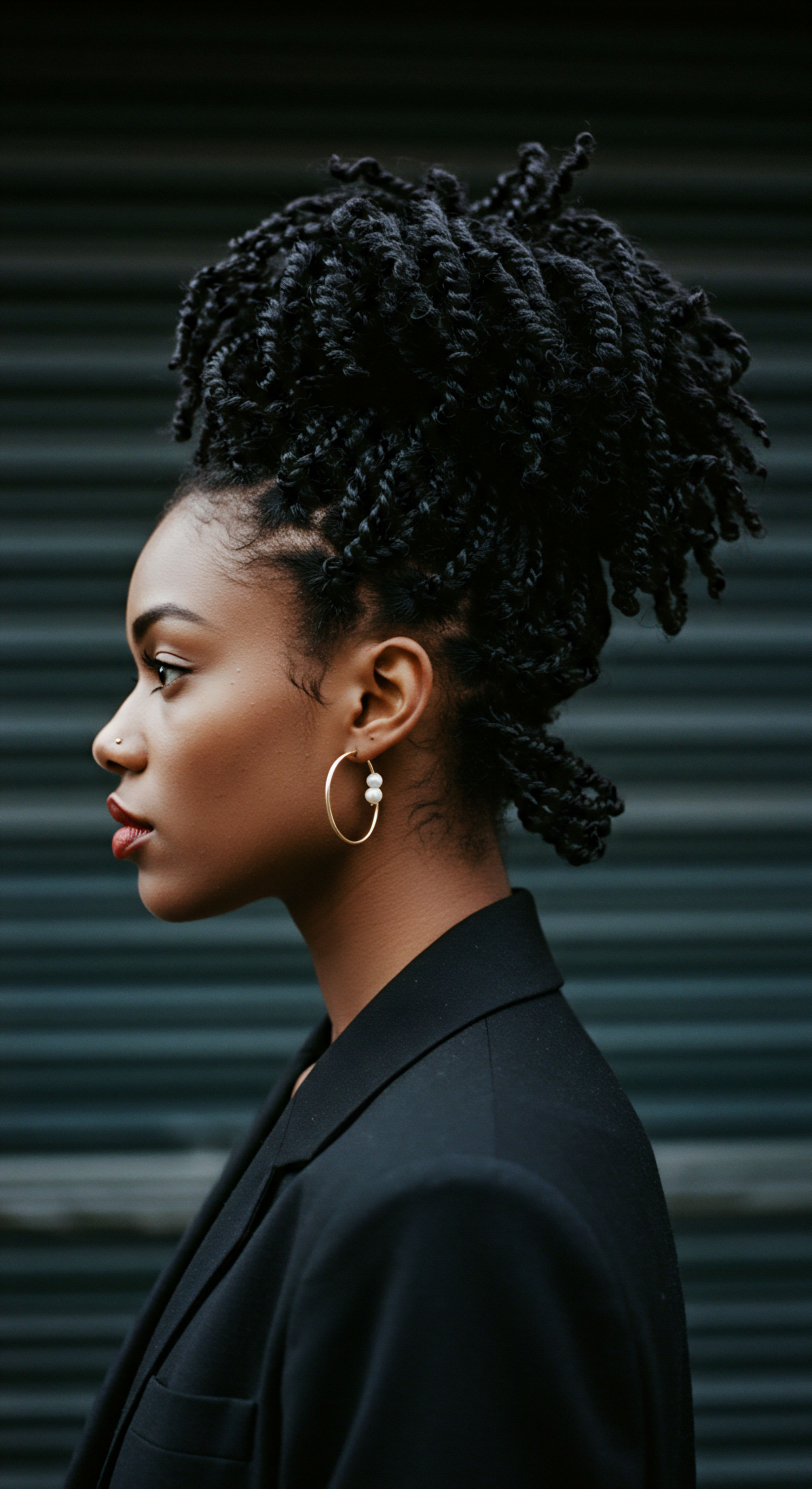
Roots
A quiet observation settles upon us when we consider the vibrant coils, gentle waves, and distinct kinks that adorn so many heads. These textured strands, each a testament to heritage and individuality, hold within their very structure a subtle, yet profound, story of hydration. It is a story whispered by the hair’s outer layer, the cuticle, and at the heart of this tale lie tiny, unassuming lipids known as ceramides.
These are not merely superficial components; rather, they serve as foundational elements, shaping how moisture interacts with hair from its innermost core to its outermost surface. Understanding ceramides means stepping into the molecular dance that defines the very feel and responsiveness of textured hair.
To truly grasp the impact of ceramides, one must first appreciate the intricate architecture of a single hair strand. Think of hair not as a simple filament, but as a sophisticated biological creation. At its center lies the medulla, a soft, often discontinuous core. Surrounding this is the cortex, the primary mass of the hair, composed of keratin proteins that give hair its strength, elasticity, and pigment.
Encasing both these layers is the cuticle, a protective shield formed by overlapping, scale-like cells. These scales, like tiny shingles on a roof, lie flat when healthy, providing a smooth surface that reflects light and seals the hair’s inner hydration. This outermost layer, the cuticle, is where ceramides exert their most immediate and profound influence.

What Are Ceramides in Hair Structure?
Ceramides are a specific class of fatty acids, a type of lipid, naturally present within the cuticle. They reside in the intercellular spaces, acting as a kind of biological mortar. Their presence is a quiet assurance, holding the cuticle cells tightly together, preventing them from lifting or becoming dislodged.
Without this molecular cohesion, the cuticle’s integrity falters, leaving the hair vulnerable. This lipid cement is not merely a structural component; it is a dynamic participant in the hair’s capacity to maintain its inherent moisture balance.
The hair shaft’s lipid composition is a complex blend, with ceramides standing as a key player among cholesterol sulfate, free fatty acids, and 18-methyleicosanoic acid (18-MEA). These lipids contribute significantly to the hair’s barrier function, its ability to retain water, and the overall cohesion of its cells. When this delicate lipid barrier is compromised, the hair’s natural defenses weaken, leading to a cascade of undesirable effects.
Ceramides act as a natural biological mortar, holding hair cuticle cells tightly together to maintain the strand’s protective barrier and moisture balance.

How Hair Absorbs and Releases Moisture
Textured hair, with its unique structural characteristics, possesses a particular relationship with water. The curls, coils, and kinks create points where the cuticle may naturally be more exposed or prone to lifting. When the hair absorbs water, it swells. When it releases water, it contracts.
This constant swelling and contracting, often exacerbated by environmental humidity changes, styling practices, and cleansing routines, can stress the cuticle. The ceramide-rich intercellular cement plays a quiet yet steadfast role in moderating this process.
A healthy ceramide presence helps to regulate the rate at which water enters and exits the hair shaft. This regulation is critical for textured hair, which can be prone to rapid water loss due to its cuticle structure and surface area. When ceramides are abundant and organized, they form a more robust barrier, slowing down evaporation and helping the hair retain its internal hydration for longer periods. This inherent ability to govern water movement is a fundamental aspect of hair wellness.
Conversely, a depletion of ceramides directly impacts this delicate equilibrium. When the intercellular cement is weakened, gaps appear between the cuticle scales. These openings serve as pathways for moisture to escape, leading to dryness, brittleness, and a lack of suppleness.
The hair becomes more susceptible to external aggressors, losing its inherent softness and responsiveness. Understanding this foundational role of ceramides sets the stage for comprehending how their presence, or absence, shapes the lived experience of textured hair.

Ritual
Moving from the foundational understanding of hair’s architecture, we turn our attention to the daily and periodic practices that shape our hair’s experience. The thoughtful application of products and the mindful execution of care routines transform abstract scientific principles into tangible benefits. For textured hair, where moisture is often a fleeting guest, incorporating ceramides into a care regimen transcends mere product application; it becomes a deliberate ritual of replenishment and fortification. This section explores how ceramides fit into this practical wisdom, offering gentle guidance for their purposeful inclusion.

Replenishing Lost Ceramides
Daily life and styling choices often strip hair of its natural ceramides. Factors such as regular cleansing with certain surfactants, the application of heat for styling, chemical treatments like coloring or relaxing, and even environmental exposure to UV rays can compromise the hair’s lipid layer. When this protective barrier is diminished, hair becomes more porous, feeling dry, rough, and susceptible to breakage. This is where external supplementation of ceramides becomes a practice of restoration.
Hair care products formulated with ceramides or ceramide-like compounds are designed to supplement these naturally occurring lipids. These exogenous ceramides work to mimic the hair’s own structure, helping to reseal the lifted cuticle scales and fill in the gaps within the intercellular cement. The goal is to restore the cuticle’s smooth, intact surface, which then aids in holding moisture within the hair shaft. This process helps hair regain its soft feel, improved texture, and reflective shine.
Integrating ceramide-enriched products into a hair care regimen helps restore the cuticle’s integrity, thereby improving moisture retention and the hair’s overall resilience.

Which Ceramide Products Can Support Moisture?
The market offers a range of products containing ceramides, from shampoos and conditioners to masks and leave-in treatments. The choice depends on the specific needs of one’s hair and the desired depth of replenishment.
- Ceramide-Infused Shampoos ❉ While cleansing, these formulations can help to minimize the stripping of natural lipids and deposit a gentle layer of ceramide-like compounds, preparing the hair for subsequent moisturizing steps.
- Ceramide Conditioners ❉ Applied after cleansing, these products work to smooth the cuticle, aiding in detangling and providing an immediate sensation of softness while depositing beneficial lipids.
- Deep Conditioning Masks with Ceramides ❉ These treatments offer a more concentrated dose of ceramides, allowing for deeper penetration and more substantial repair of the hair’s outer layer. They are particularly beneficial for hair that has experienced significant damage or persistent dryness.
- Leave-In Ceramide Treatments ❉ For ongoing protection and moisture sealing, leave-in products provide a continuous shield against environmental stressors and styling friction, helping to maintain the integrity of the hair throughout the day.
When selecting products, looking for terms like “ceramide NP,” “ceramide II,” or “ceramide III” on ingredient lists indicates the presence of these beneficial lipids. Some formulations may also contain ceramide precursors or plant-derived lipids that mimic ceramide function, providing a similar restorative action.

How Do Ceramides Prevent Water Loss?
The mechanism by which ceramides aid in moisture retention is quite direct. By acting as a sealant for the cuticle, they create a stronger barrier against transepidermal water loss from the hair shaft. Consider the hair cuticle as a collection of overlapping scales.
When these scales are lifted or damaged, water molecules can easily escape from the hair’s interior into the surrounding air. Ceramides work to flatten and bind these scales, closing off the pathways for water evaporation.
This sealed environment allows the hair to maintain its optimal hydration levels, contributing to its flexibility, elasticity, and softness. For textured hair, which can naturally possess a more open cuticle structure, this barrier function is particularly important. A robust ceramide layer means less reliance on external humidity and a greater capacity for the hair to hold onto the moisture it receives from products or water. This thoughtful application of ceramide-rich care becomes a daily ritual of nurturing, allowing textured hair to flourish with greater suppleness and vitality.

Relay
Stepping into a deeper consideration of textured hair’s moisture balance, we encounter a confluence of biological nuances, historical insights, and contemporary research. The conversation around ceramides in textured hair extends beyond simple application; it delves into the very composition of different hair types and the subtle ways these distinctions shape their interaction with the world. This section aims to unravel these layers, connecting the science of ceramides to broader understandings of hair health, cultural practices, and even the often-overlooked disparities in scientific inquiry.

Are Ceramide Levels Different Across Hair Types?
A compelling area of study involves the intrinsic differences in lipid composition across various hair types, particularly between African, Asian, and Caucasian hair. While some research suggests that African hair possesses a higher overall lipid content—up to 6% compared to Caucasian hair’s 3% and Asian hair’s 2%—this generalization warrants a closer look at the specific types and organization of those lipids. A deeper investigation reveals that despite a higher total lipid presence, the specific composition of ceramides within African hair may present a distinct challenge.
For instance, a study by Cavaco-Paulo et al. (2013) published in the International Journal of Cosmetic Science observed that African hair, while indeed richer in cholesterol ester and cholesterol sulfate, exhibited a smaller amount of ceramides when compared to Asian and Caucasian hair. This specific finding offers a counter-intuitive perspective ❉ more overall lipids do not necessarily equate to more of the specific lipid class—ceramides—that is so critical for cuticle cohesion and moisture retention. This particularity could contribute to the observed differences in water handling and susceptibility to damage in textured hair.
Consider the implications ❉ if textured hair naturally possesses a relatively lower concentration of these crucial binding lipids, it might inherently struggle more with maintaining cuticle integrity and preventing moisture loss. This scientific detail provides a foundational understanding for why textured hair often feels drier and appears more prone to breakage, even when seemingly well-cared for. It is a biological predisposition that necessitates a more intentional and ceramide-focused approach to hair care.
While African hair may contain a higher total lipid content, some research indicates a comparatively lower amount of ceramides, which could influence its moisture retention capacity.

How Do Ceramides Influence Hair Permeability and Resilience?
The role of ceramides extends to influencing the hair’s permeability—its capacity to allow substances, including water, to pass through its outer layers. When ceramide levels are robust, they create a formidable barrier, reducing the hair’s tendency to absorb excessive water quickly and, more importantly, to lose it just as rapidly. This controlled exchange of moisture is vital for maintaining the hair’s mechanical properties, such as its strength and elasticity.
Research has shown that hair with depleted ceramides exhibits increased permeability and a greater tendency for moisture desorption. This heightened permeability renders the hair more susceptible to damage from environmental stressors, chemical treatments, and physical manipulation. For textured hair, which is often subjected to diverse styling methods and can experience greater mechanical stress due to its coiling patterns, maintaining this ceramide-driven barrier is paramount.
An illustrative study examining the impact of UV radiation on different hair types provides further insight. African hair samples, despite some general claims of higher total lipid content, demonstrated more severe surface damage after UV exposure compared to Asian hair. This suggests that the quality or organization of the lipid barrier, perhaps influenced by ceramide levels or their specific composition, plays a more significant role in protection than mere quantity. The researchers concluded that integral hair lipids likely protect against UV light, implying that a compromised lipid barrier, even if seemingly “lipid-rich” in total, leads to increased vulnerability.
This nuanced understanding guides us toward appreciating ceramides not just as a cosmetic ingredient, but as a critical component in the hair’s inherent defense system. Their presence directly impacts the hair’s ability to resist external aggressors and maintain its internal hydration, thereby contributing to its long-term health and resilience.
| Hair Property Moisture Retention |
| Impact of Healthy Ceramide Levels Locks in water, reduces evaporation |
| Consequence of Ceramide Depletion Increased water loss, dryness, dehydration |
| Hair Property Cuticle Integrity |
| Impact of Healthy Ceramide Levels Smooth, flat scales; strong cohesion |
| Consequence of Ceramide Depletion Lifted, ragged scales; increased porosity |
| Hair Property Strength & Elasticity |
| Impact of Healthy Ceramide Levels Reinforced hair shaft; less breakage |
| Consequence of Ceramide Depletion Weakened fibers; brittleness, split ends |
| Hair Property Surface Smoothness |
| Impact of Healthy Ceramide Levels Silky feel; enhanced light reflection (shine) |
| Consequence of Ceramide Depletion Rough texture; dullness, frizz |
| Hair Property Protection from Damage |
| Impact of Healthy Ceramide Levels Barrier against chemical, heat, UV stressors |
| Consequence of Ceramide Depletion Higher susceptibility to environmental harm |

Do Ceramides Support Hair Growth?
While ceramides are primarily recognized for their role in the structural integrity and moisture balance of the hair shaft, a burgeoning area of research explores their indirect influence on hair growth. Ceramides are not growth stimulants in the direct sense of promoting follicle activity like some other compounds. However, their contribution to a healthy scalp environment and a strong hair shaft creates optimal conditions for growth to occur.
A healthy scalp is the very foundation from which healthy hair emerges. Ceramides contribute to the skin’s barrier function on the scalp, helping to prevent dryness, irritation, and flakiness. A compromised scalp barrier can lead to inflammation or discomfort, which can, in turn, impede healthy hair production. By maintaining the scalp’s integrity, ceramides indirectly support the hair follicles, allowing them to function in a more favorable environment.
Moreover, by strengthening the hair shaft and reducing breakage, ceramides help in length retention. Hair that is less prone to snapping and splitting can grow longer and appear fuller, even if the rate of growth from the follicle remains unchanged. A study published in Annals of Dermatology (2019) explored the effect of synthetic ceramides on human dermal papilla cells (hDPCs), which play a crucial role in hair growth.
The study found that synthetic ceramides could increase the proliferation of these cells, suggesting a potential, albeit indirect, contribution to hair growth by fostering a healthier cellular environment within the follicle. This opens a fascinating avenue for future research and product development, underscoring the multifaceted value of these unassuming lipids.

Reflection
As we draw our thoughts together, the quiet wisdom of ceramides in the story of textured hair’s moisture becomes beautifully clear. They are the unseen architects of suppleness, the steadfast guardians of hydration, and the subtle orchestrators of resilience. Their presence speaks to a deeper connection between the hair’s biological blueprint and its vibrant expression in the world. Recognizing the specific needs of textured hair, informed by the delicate balance of its internal lipids, invites a more mindful approach to care—one that honors its inherent beauty and supports its strength with gentle, knowing hands.

References
- Cavaco-Paulo, A. et al. “Keratins and lipids in ethnic hair.” International Journal of Cosmetic Science, vol. 35, no. 3, 2013, pp. 244-249.
- Hallegot, P. et al. “Ceramide binding to African–American hair fibre correlates with resistance to hair breakage.” International Journal of Cosmetic Science, vol. 22, no. 4, 2000, pp. 239-248.
- Kim, H. et al. “Synthesized Ceramide Induces Growth of Dermal Papilla Cells with Potential Contribution to Hair Growth.” Annals of Dermatology, vol. 31, no. 2, 2019, pp. 164-174.
- Lee, Y. et al. “The Ethnic Differences of the Damage of Hair and Integral Hair Lipid after Ultra Violet Radiation.” Annals of Dermatology, vol. 25, no. 1, 2013, pp. 54-61.
- McMullen, R. “Hair Lipid Structure ❉ Effect of Surfactants.” Cosmetics, vol. 10, no. 3, 2023, p. 74.
- Davis-Sivasothy, Audrey. The Science of Black Hair ❉ A Comprehensive Guide to Textured Hair Care. Sivasothy, 2011.
- Méndez, S. et al. “Damaged hair retrieval with ceramide-rich liposomes.” Journal of Cosmetic Science, vol. 62, no. 5, 2011, pp. 483-492.
- Robbins, Clarence R. Chemical and Physical Behavior of Human Hair. 5th ed. Springer, 2012.
- Ruetsch, S. B. et al. “The what, why and how of curly hair ❉ a review.” International Journal of Cosmetic Science, vol. 41, no. 6, 2019, pp. 523-535.
- Kojima, M. et al. “Restoring Hair and Scalp Health ❉ Ceramide-2 Analog for Conditioning and Barrier Benefits.” Cosmetics & Toiletries, vol. 133, no. 2, 2018, pp. 44-48.